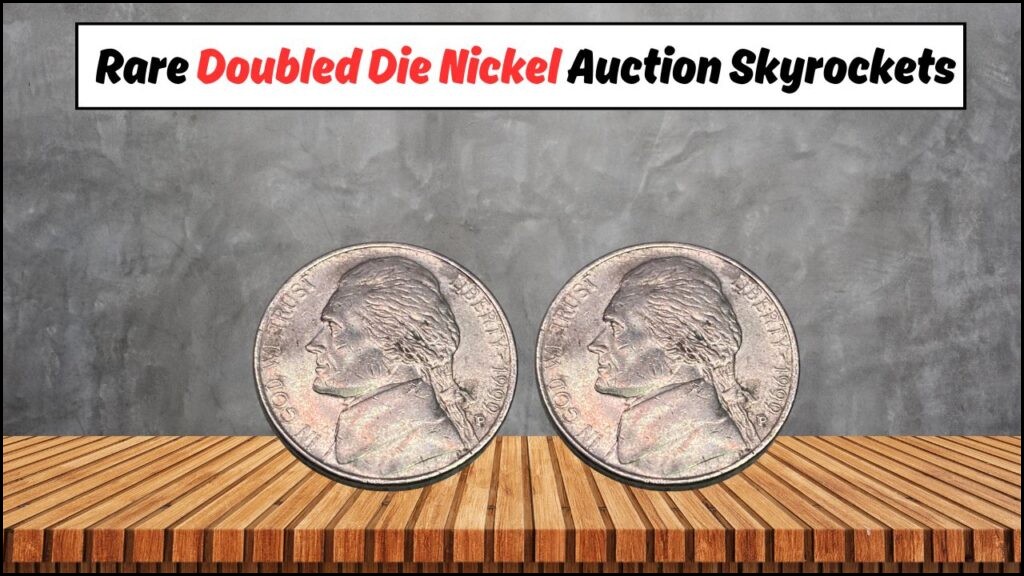1999 Doubled Die Nickel – In the fascinating world of numismatics, the unexpected often creates a storm. One such example took the coin collectors’ community by surprise when an ultra-rare 1999 Doubled Die Jefferson Nickel soared to an astonishing $9,200 in just a single day at an online auction. With its doubling error on specific features, this humble nickel—often overlooked by casual collectors—has suddenly turned into a hot investment item. The coin’s sudden spotlight in July 2025 has sparked renewed interest among coin enthusiasts, dealers, and even casual treasure hunters. But what exactly is a doubled die coin, and why is this specific 1999 nickel commanding such high value in the collectors’ market? This article explores the unique features, origin, rarity, and current market scenario for the 1999 Doubled Die Nickel, including a breakdown of auction trends and tips for spotting one in your change jar.
What Is a Doubled Die Coin and Why It Matters?
A doubled die coin is created during the minting process when the die used to strike the design on the coin has a misalignment or duplication. This leads to key elements like the date, lettering, or facial features appearing doubled.
Key Characteristics of Doubled Die Nickels:
- Doubling appears mostly on the date “1999”, “Liberty”, and Jefferson’s eye and hairline.
- The doubling is not from wear or damage but originates during the die creation phase.
- Most are found in uncirculated or lightly circulated condition.
Recent Auction: A Timeline of the $9,200 Shock Sale
On July 25, 2025, an online numismatic auction saw a bidding war for one such rare 1999 Doubled Die Nickel. Starting at only $500, within 24 hours, the final hammer price closed at $9,200, shocking even the auctioneers.
Auction Breakdown Table:
| Auction Detail | Information |
|---|---|
| Auction Date | July 25, 2025 |
| Starting Bid | $500 |
| Final Sale Price | $9,200 |
| Bidders Participated | 17 |
| Grading | NGC MS66 |
| Auction Platform | GreatCollections |
| Seller’s Location | Arizona, USA |
| Winning Bidder | From Pennsylvania, USA |
Market Value of Doubled Die Nickels – Then vs Now
While most 1999 nickels are worth face value, a small number with doubling errors command much higher premiums. Their value depends on condition, clarity of the doubling, and grading by third-party services.
Value Comparison Table:
| Coin Condition | Average Market Value | Auction Potential Value |
|---|---|---|
| Circulated | $10–$40 | Rarely auctioned |
| AU (Almost Uncirculated) | $100–$300 | $500–$800 |
| MS63–MS65 | $500–$1,500 | $2,000–$5,000 |
| MS66 and Above | $2,000–$4,500 | Up to $9,200+ |
Where to Look for 1999 Doubled Die Nickels
You don’t need to be a professional dealer to get lucky. These rare nickels are sometimes still found in regular coin rolls, change, or inherited collections.
Tips to Spot One:
- Use a 10x magnifying glass.
- Focus on the “Liberty”, “IN GOD WE TRUST”, and Jefferson’s eye.
- Check online coin forums for side-by-side images.
- Compare with regular 1999 nickels to see any doubling.
Should You Get It Graded?
If you believe you’ve found a 1999 Doubled Die Nickel, grading can add significant value. Top grading agencies like PCGS or NGC authenticate and certify coins based on condition and authenticity.
Benefits of Grading:
- Increases resale value.
- Makes it eligible for high-value auctions.
- Provides official certification for collectors.
- Prevents disputes during online sales.
Why This Auction Matters for Collectors in 2025
This event signals growing demand in the error-coin market, especially for coins from the late 1990s and early 2000s. Young collectors and online influencers are now flocking to coins with quirky production flaws like off-center strikes, planchet errors, and doubled dies.
The $9,200 sale has set a new benchmark and could encourage people to re-examine their old coin jars. As more of these nickels come to light, prices might fluctuate, but the value of high-grade examples is expected to remain strong.
What This Means for the Future of Coin Collecting
The future of coin collecting is becoming more digital, community-driven, and driven by rarity over age. Coins like the 1999 Doubled Die Nickel gain popularity quickly through social media hype and auction results.
Collectors should:
- Stay updated on auction trends.
- Join numismatic communities online.
- Be open to investing in modern error coins.
FAQs of 1999 Doubled Die Nickel
Q1. How can I tell if my 1999 nickel is a doubled die?
A1. Look for clear doubling on the date “1999”, “Liberty”, and Jefferson’s eye using a magnifying glass.
Q2. Are all 1999 nickels valuable?
A2. No, only those with the doubled die error are valuable—most regular ones are worth face value.
Q3. Where can I sell a rare coin like this?
A3. Trusted platforms include GreatCollections, Heritage Auctions, and eBay (for certified coins).
Q4. Is grading necessary before selling?
A4. Yes, grading boosts credibility and value significantly in high-stakes auctions.
Q5. How many 1999 doubled die nickels exist?
A5. The exact number is unknown, but experts estimate fewer than 1,000 confirmed examples exist.






